 Download this article in magazine layout
Download this article in magazine layout
- Share this article
- Subscribe to our newsletter
Moving towards resilient farming in northern Ethiopia
Rainfed dependent crop-livestock mixed farming has been a common practice in the drylands of Atsbi-Womberta district of northern Ethiopia, where rainfall is extremely variable. With increasing population pressure, the cultivation of crops and farming expanded to hilly sites unsuitable for cultivation of crops. The cutting and use of trees for wood, fuel and other purposes reduces the vegetation cover substantially. The reduced vegetation cover resulted in severe erosion in the hilly sites and the burial of fertile bottomlands by infertile gravels from the upper hilly sites. In aggregate, these developments ultimately led to land degradation and many food insecure households in the Barka-Birki watersheds, Atsbi-Womberta district of northern Ethiopia.
Reversing watershed degradation and food insecurity has been one of the major development challenges in the semi-arid areas of northern Ethiopia. As an entry point, the government of Ethiopia launched and mobilised community based physical soil and water conservation at village and watershed levels. Conservation was initiated on cultivable lands and gradually extended to watershed levels. The conservation and enclosure of watersheds have resulted in improved water retention capacity and recovery of perennial bee forage plants in upstream hilly sides, and revitalised surface and groundwater in the downstream of the watersheds.
The project “Improving Productivity and Market Success” (IPMS-ILRI), directed by the International Livestock Research Institute (ILRI) and funded by the Canadian International Development Agency (CIDA), concluded in its first survey that despite the intensive interventions in watershed conservation and recovery, the contribution to the economy of smallholder farmers had been low. The watershed approach had been useful to harmonise the use of soil, water and vegetation in a way that conserved these resources and improved household income. The IPMS project argues that the watershed management can be improved with market-oriented commodity developments along the watershed resources gradient: upstream, valley bottoms and downstream.
In order to increase benefits to farmers, the IPMS project, in collaboration with public partners, mainly the district Office of Agriculture and Rural Development, introduced and tested market-oriented commodity development interventions along the resources gradient of the Barka-Birki watershed of Atsbi-Womberta district, northern Ethiopia. The interventions were participatory, demand driven, skill and knowledge based. The introduction, testing and promoting of market-oriented commodity development in Atsbi-Womberta district started in 2005/06. The objective of this paper is to present the response to the integrated interventions along the watershed resources gradient.
Watershed resources gradient and commodity interventions
The conserved Barka-Birki watershed is characterised by a variation in resources abundance (water, soil and vegetation) along the watershed continuum-upstream hilly sides, bottomlands and downstream sites. The upstream hilly sides are usually with shallow soil depth and moisture retention, and can support the seasonal growth of perennial vegetation, particularly under rainwater harvesting and retention measures. The bottomlands with deep soil depth and high moisture retention can support annual and perennial vegetation, and plants stay green longer than the unprotected watersheds. The downstream sites are usually rich with surface and groundwater resources and are suitable for irrigated crops development such as vegetables and fodder.
The types of market-oriented development interventions were varied according to the resources gradient of the watershed (see Figure above). Beekeeping development interventions were targeted in the upstream hilly sites, where there is high cover-abundance of bee forage plants. Sheep fattening development interventions were focused on the bottomlands, where the lush growth and biomass of forage availability is high. Most of the bottomland forage sources were transformed from open grazing into a cut-and-carry system of livestock feeding. With increased vegetation cover in the hilly sites and bottomlands, runoff decreased, infiltration increased and direct loss of moisture by evaporation was reduced. This enriched the surface and groundwater in the downstream sites of the Barka-Birki watershed. High-value irrigated crop development interventions were targeted in the downstream of the watershed.
The key interventions by IPMS and partners in market-oriented commodity development included technical knowledge and skill development of farmers, extension service providers and other relevant partners along the commodity value chain development. The value chain-based interventions comprised improved technologies, processing and establishment of market linkages and access to improved inputs of beekeeping, sheep fattening and high-value irrigated crops. Beekeeping value chain interventions included improvement in bee forage availability, colony multiplication, improved hive use and management, honey harvesting techniques, storage and grading, and market linkages. Similar intervention approaches followed for sheep fattening. For high-value irrigated crops, interventions comprised the selection of high-value crops (onion, tomato, pepper and garlic), supply of planting materials, implement demonstration, operation and maintenance, and market linkages.
Contribution to household income
Results of the development interventions show that in the upstream watersheds, the average net income of the beekeeping adopter households increased by about threefold between 2005 and 2009 (see Figure). A honey productivity trend of adopters and non-adopters was consistent over several seasons where the rainfall amount and distribution varied considerably.
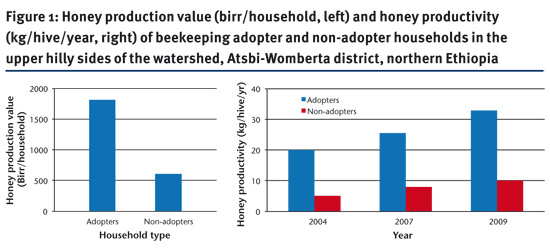
In the bottomlands, the increase in forage covers slowed down runoff and increased infiltration and soil trapping. During the dry season, stubbles were maintained at 10–20 centimetres. The stubble soil cover reduced the unproductive loss of water through evaporation. Better soil moisture retention and fertile soil trapping in the bottomlands increased the frequency of annual forage harvest to three. Aggregately, total forage biomass grew about fivefold following the introduction of the cut-and-carry system of livestock feeding interventions. Similarly, the number of fattened sheep and income had increased fivefold in the bottomlands by 2009 compared to 2005 (see Figure).
The net income of adopter farmers rose ninefold in the irrigated downstream of the watersheds as compared to the income of farmers from the non-intervention watersheds (see Figure 3, left). The increase in household income was associated with the shifts in cropping pattern from traditional low-value cereal crops (barley and wheat) to high-value crops such as vegetables and spices (see Figure 3, right). Because of the seasonal supply of water in the irrigated sites, farmers shifted to intensification and diversification of high-value crops such as pulses (faba bean and field pea) to exploit market niches during the dry season. Pulses have been a preferred food for workers in the sesame growing lowlands of north-western Ethiopia. The harvesting of irrigated pulses in April or May coincides with the peak demand in the lowlands, and irrigated-pulse growers fetch higher prices (40–50 % higher) without competition from the rainfed pulses, which are harvested in October. Moreover, the integration of pulses into a vegetable system has proved to break insect and disease cycles and to improve soil fertility.
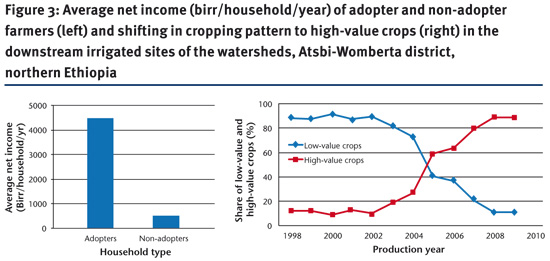
Promotion for improved uptake of successes
Market-oriented commodity (beekeeping, sheep fattening and irrigated crops) development along the watershed resources gradient has been successfully implemented for the improved benefit of the rural community. The processes and results of integrating market-oriented commodity development along the conserved watershed resources gradient has been demonstrated and promoted through awareness creation, discussion forums, field visits and tours for selected farmers, community leaders, experts, researchers and decision-makers outside the tested watersheds. Integrating market-oriented commodity development into the conserved watersheds has become part of the district programme. The discussion forums and field visits were found to be the most successful approaches to promote the success of market-oriented commodity development along the conserved watershed gradient.
Conclusion
In the upper stream of the conserved watershed, bee forage plants, mostly with deep-rooted perennial shrubs, are able to extract moisture deep in the soil, stay green and blossom longer than in the unprotected sites. Drained water from the upper stream has contributed to the development of year-round green forage in the bottomlands, which improves the performance of fattened sheep and household income. Runoff slowdown along the upper stream and in the bottomlands contributed to the development of surface and groundwater in the downstream of the watershed. This is the source of water useful for irrigated crops development to sustain crop production in seasons when the traditional crops fail to produce grain and declined livestock productivity in the non-intervention sites.
Gebremedhin Woldewahid
Berhanu Gebremedhin
Dirk Hoekstra
Azage Tegegne
International Livestock Research Institute (ILRI)
Addis Ababa, Ethiopia


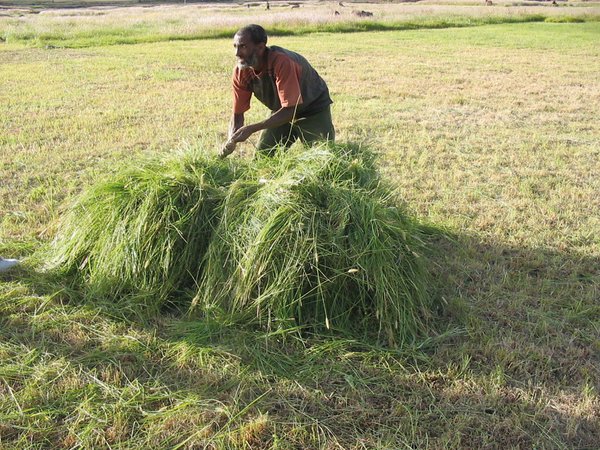
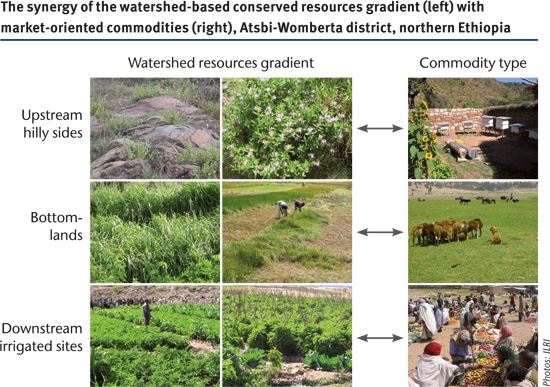
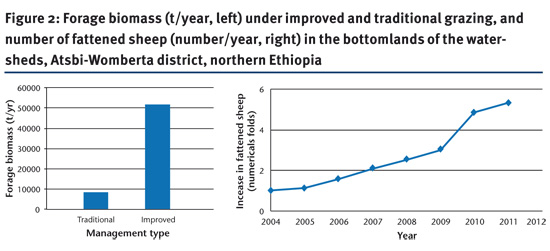


Add a comment
Be the First to Comment